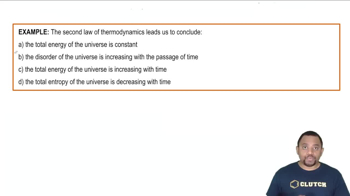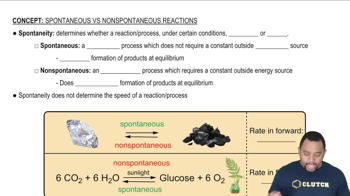The values of ΔG°f for the hydrogen halides become less negative with increasing atomic number. The ΔG°f of HI is slightly positive. However, the trend in ΔS°f is to become more positive with increasing atomic number. Explain.
Is the sign of ΔSuniv for each process positive or negative? Explain for the following: b. the electrolysis of H2O(l) to H2(g) and O2(g) at 298 K c. the growth of an oak tree from a little acorn.
 Verified step by step guidance
Verified step by step guidanceKey Concepts
Entropy (ΔS)

Second Law of Thermodynamics

Spontaneity of Processes

Dinitrogen tetroxide decomposes to nitrogen dioxide: N2O4(g) → 2 NO2(g) ΔH°rxn = 55.3 kJ At 298 K, a reaction vessel initially contains 0.100 atm of N2O4. When equilibrium is reached, 58% of the N2O4 has decomposed to NO2. What percentage of N2O4 decomposes at 388 K? Assume that the initial pressure of N2O4 is the same (0.100 atm).
Indicate and explain the sign of ΔSuniv for each process. a. 2 H2(g) + O2(g) → 2 H2O (l) at 298 K.
A metal salt with the formula MCl2 crystallizes from water to form a solid with the composition MCl2 • 6 H2O. The equilibrium vapor pressure of water above this solid at 298 K is 18.3 mmHg. What is the value of ΔG for the reaction MCl2 • 6 H2O(s) ⇌ MCl2(s) + 6 H2O(g) when the pressure of water vapor is 18.3 mmHg? When the pressure of water vapor is 760 mmHg?
